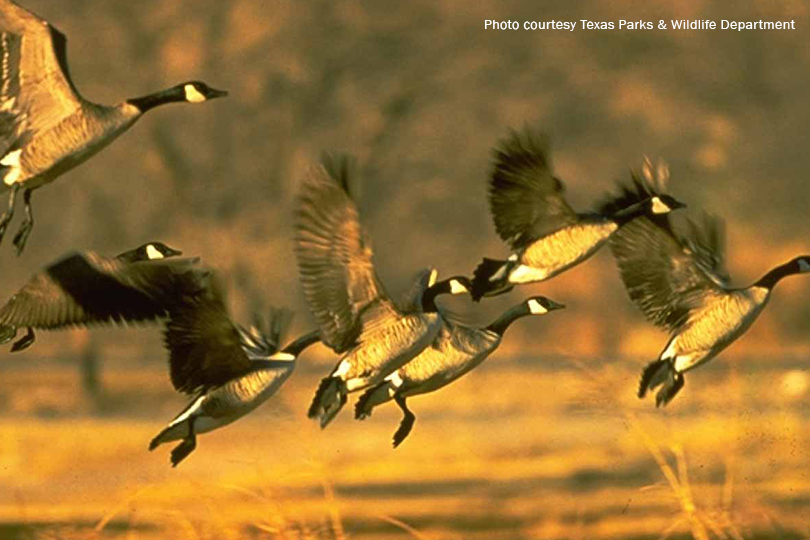By Jessica Domel
Multimedia Reporter
Texas hunters may have to do a bit more scouting to bag a goose this year, thanks to drought in some areas and changes in the weather.
In the parts of the Panhandle that have been gripped by drought for months, geese have made their way into urban areas where they have more reliable water sources.
“Most of the cities and small towns in the Texas Panhandle have city parks that have ponds, and they have their fountains. These small Canada geese that typically visit the Panhandle, that are attracted to the Playa wetlands, have now adapted and have taken very abundantly to these urban ponds,” Kevin Kraai, Waterfowl Program leader for the Texas Parks and Wildlife Department, said in an interview with the Texas Farm Bureau Radio Network.
He said at one point, tens of thousands of small Canada geese could be found roosting on the ponds and then flying outside the city limits twice a day.
“Even though it’s been very dry, hunters are still being very successful in targeting these birds there,” Kraai said. “As you move south to the Rolling Plains, there’s an area north of Abilene that has a very, very large population, mostly dominated by white-fronted geese.”
The area is wetter, and hunters have been successful near Abilene.
The Texas Gulf Coast used to be the snow goose capital of the world, but due to population declines, habitat changes and a warm climate, there aren’t as many snow geese now.
In December, Kraai said the stretched out migration contributed to a decline in goose numbers along the coast.
Loss of habitat, like rice fields, along the coast is also impacting goose numbers.
“Historically, that landscape was dominated by rice agriculture, and that’s what really attracted those birds to that landscape,” Kraai said. “Over the years, we’ve just lost a lot of that rice agriculture, and snow geese have really learned to adapt and stay further north, stay on larger, deeper bodies of water and are taking advantage, if you will, of an abundance of corn on the landscape in the Midwest.”
In the past, Texas was the top wintering ground for snow geese.
Now, the state falls behind Kansas, Arkansas and Illinois.
The light and dark geese hunting season for the West Zone is open through Feb. 14.
The season for the South Zone ends Jan. 31.
The statewide bag limit for geese during the regular season includes: five dark geese, of which no more than two can be a white-fronted goose, and 10 light geese.
The light geese conservation order opens Feb. 15 in the West Zone and runs through March 14.
In the East Zone, the conservation order opens Feb. 1 and runs through March. 14.
The western zone is west of a line from the International Toll Bridge at Laredo, north following IH-35 and 35W to Forth Worth, northwest along U.S. Highway 81 and 287 to Bowie and north along Highway 81 to the Texas-Oklahoma state line.
The eastern zone is the rest of the state.
“A conservation order is actually not technically a hunting season,” Kraai explained. “This was a management action that was enacted by Congress a number of years ago, back in the late 1990s, to address an overabundance issue with snow geese.”
At the time, the population was growing extensively, which was negatively impacting the area they use for breeding grounds.
“So, at the end of our waterfowl season—duck and goose season—the conservation order opens up, and it’s just for light geese,” Kraai said. “That’s snow geese, blue-face snow geese and the Ross’ geese. We have an extended period of take that is allowed with liberalized regulations. Bag limits and things like that are lifted when the conservation order begins.”
All hunters must carry with them a valid Texas hunting license and a migratory game bird stamp endorsement. A valid federal duck stamp and Harvest Information Program (HIP) certification are required for hunters 16 years of age and older.
Hunters born on or after Sept. 2, 1971, must have completed hunter safety education or have an approved deferral.
A map of the goose hunting zones is available, along with hunter regulations, in the TPWD Outdoor Annual.

